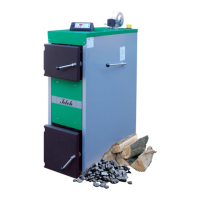23. PRACTICAL ADVICE TO THE USER
Hygrometer
The manufacturer recommends having a hygrometer, which is very useful for checking wood
humidity at the time of its purchase or ongoing inspection of stored wood.
Why use a chimney liner?
Using solid fuels in traditional boilers, i.e. top burning boilers, a relatively large
amount of heat and a significant part of harmful gases is emitted into the atmosphere. This
way you spend your money, and these are quite large amount to heat the chimney and the
atmosphere. To change these proportions, i.e. transfer as large a portion of heat to radiators
(and thus dedicate it for room heating), we offer you a modern, environmentally-friendly
bottom combustion boiler. This way a huge portion of heat you have lost so far will heat what
you really want to, i.e. the space of rooms. Therefore it means that since we lose less heat,
but also the exhausted flue gas is much cooler, and thus stop heating the chimney.
Sometimes, however cooler flue gas exhausted through old, often leaky chimney condense,
which can cause chimney wall rising damp. To achieve maximum boiler operating efficiency
(i.e. cost-effective operation) and avoid any damage, just like any world-class bottom-
combustion boiler manufacturers, We recommend that chimney liner or other features
protecting the chimney against condensate absorption. Those manufacturers, who do not do
it, intentionally expose you to significant problems and unnecessary costs. You need to be
aware that if you want to incur low costs for heating, when you use a modern boiler, you
have to connect it to a modern chimney (just like with a car – lead-free fuel and the catalyst).
We guarantee that you will be very satisfied and the cost will be recovered instantly,
especially as the fuel prices keep growing and will continue to do so.
Chimney test for self-testing during chimney operation
1. Test if the boiler is clean (fire bridges, burners, grate, breeching).
2. Kindle the boiler.
3. Switch the blowing off.
4. Open fully the (top) fuel loading door.
5. Open the boiler furnace (bottom) door.
6. Close the by-pass device.
After completing these operations (dry!) fuel should burn intensely and no smoke should be
emitted through the fuel feeding door.
If it is otherwise, i.e. the fuel is burning slowly and smoke is emitted through open fuel
feeding door, it is indicative of an incorrect chimney operation. Call a chimney sweep.
The manufacturer will not be responsible for an incorrectly operating
chimney, or any related consequences.
The most frequent causes of wrong chimney operation:
1. The chimney should have the draft specified in the OMM (it will be defined precisely by the
chimney sweep).
2. Too small chimney cross-section.
3. Too low chimney.
4. The chimney does not protrude above the roof ridge (the highest roof point).
5. Chimney cornice – very often causes wrong chimney operation.
6. Various types of insertions increasing chimney height, but at the same time reducing its
cross-section.
7. Insertions in neighboring chimney ducts protruding above the boiler chimney duct of a
boiler for solid fuel. This often happens if two boilers are used. One burning oil, another
burning solid fuel.
8. A leaky chimney duct (crack, internal connection with other ducts, e.g. ventilation, a
cracked internal chimney partition, which you cannot identify by yourself).

